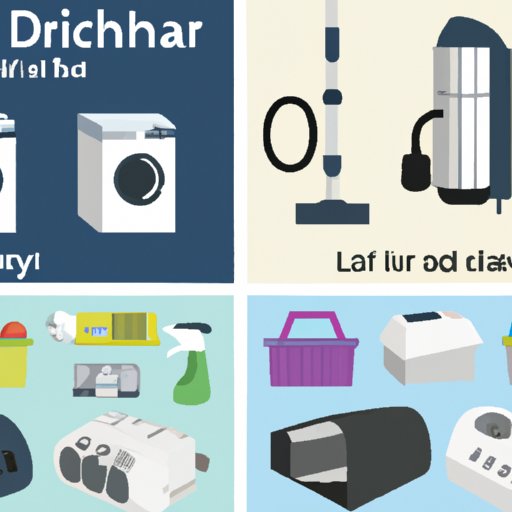Introduction
Cleaning a dryer lint trap is an essential part of home maintenance that helps prevent fires and improve the efficiency of your dryer. This article will provide a step-by-step guide to cleaning a dryer lint trap, as well as tips and tricks for effectively cleaning the lint trap and maintaining its cleanliness. Finally, it will offer a quick and easy method for cleaning your dryer lint trap.
Step-by-Step Guide to Cleaning a Dryer Lint Trap
Before starting any work on your dryer, make sure to unplug it from the wall outlet. Then, follow these steps to clean the lint trap:
- Unplugging the dryer: Unplug the dryer from the wall outlet before starting any work.
- Removing the lint trap: Carefully remove the lint trap from the dryer and set it aside.
- Cleaning the lint trap: Use a vacuum or a lint brush to remove any lint or debris from the lint trap.
- Replacing the lint trap: Once the lint trap is clean, replace it in the dryer.

Tips and Tricks for Effectively Cleaning a Dryer Lint Trap
When cleaning a dryer lint trap, there are some important tips and tricks to keep in mind:
- Use a vacuum or a lint brush: Using a vacuum or a lint brush is the most effective way to remove lint from the lint trap.
- Wear gloves when cleaning: Wearing gloves while cleaning the lint trap will protect your hands from any sharp edges or debris.
- Empty the lint trap regularly: Emptying the lint trap after every load of laundry will help keep it clean and prevent buildup of lint.
The Best Way to Keep Your Dryer Lint Trap Clean
To ensure your dryer lint trap stays clean, there are some important steps to take:
- Regularly inspect the lint trap for clogs: Inspect the lint trap for any clogs or blockages at least once a month.
- Use a dryer vent cleaning kit: Using a dryer vent cleaning kit can help clear out any excess lint or debris from the exhaust hose.
- Check the exhaust hose for blockages: Make sure to check the exhaust hose for any blockages, as this can cause the lint trap to become clogged.

How to Quickly and Easily Clean Your Dryer Lint Trap
If you’re looking for a quick and easy way to clean your dryer lint trap, here are some tips:
- Use the vacuum cleaner: Vacuuming the lint trap is the quickest and easiest way to get rid of any lint or debris.
- Use an old toothbrush: An old toothbrush can be used to get into tight spaces and remove stubborn lint.
- Use a compressed air canister: A compressed air canister can help blow away any lint or debris that is stuck in the lint trap.

The Ultimate Guide to Cleaning a Dryer Lint Trap
To ensure your dryer lint trap is always clean and functioning properly, here are some tips and tricks to follow:
- Clean the lint trap after every load: Clean the lint trap after every load of laundry to prevent any buildup of lint.
- Check the exhaust hose monthly: Check the exhaust hose for any blockages or clogs at least once a month.
- Replace the lint trap at least once a year: Replacing the lint trap at least once a year will help keep it clean and functioning properly.
Conclusion
Cleaning a dryer lint trap is an important part of home maintenance that helps prevent fires and improve the efficiency of your dryer. This article has provided a step-by-step guide to cleaning a dryer lint trap, as well as tips and tricks for effectively cleaning the lint trap and maintaining its cleanliness. Finally, it has offered a quick and easy method for cleaning your dryer lint trap.
By following these steps and tips, you can ensure your dryer lint trap is always clean and functioning properly. This will help keep your home safe and reduce the risk of fire, as well as save you money by improving the efficiency of your dryer.


